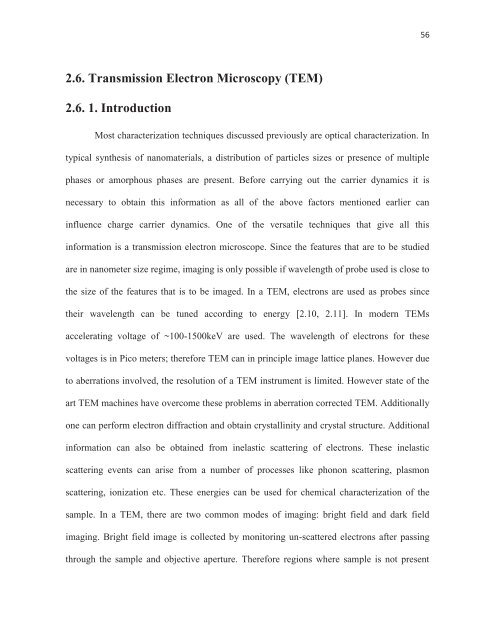CHEM01200604009 Sreejith Kaniyankandy - Homi Bhabha ...
CHEM01200604009 Sreejith Kaniyankandy - Homi Bhabha ...
CHEM01200604009 Sreejith Kaniyankandy - Homi Bhabha ...
You also want an ePaper? Increase the reach of your titles
YUMPU automatically turns print PDFs into web optimized ePapers that Google loves.
56<br />
2.6. Transmission Electron Microscopy (TEM)<br />
2.6. 1. Introduction<br />
Most characterization techniques discussed previously are optical characterization. In<br />
typical synthesis of nanomaterials, a distribution of particles sizes or presence of multiple<br />
phases or amorphous phases are present. Before carrying out the carrier dynamics it is<br />
necessary to obtain this information as all of the above factors mentioned earlier can<br />
influence charge carrier dynamics. One of the versatile techniques that give all this<br />
information is a transmission electron microscope. Since the features that are to be studied<br />
are in nanometer size regime, imaging is only possible if wavelength of probe used is close to<br />
the size of the features that is to be imaged. In a TEM, electrons are used as probes since<br />
their wavelength can be tuned according to energy [2.10, 2.11]. In modern TEMs<br />
accelerating voltage of ~100-1500keV are used. The wavelength of electrons for these<br />
voltages is in Pico meters; therefore TEM can in principle image lattice planes. However due<br />
to aberrations involved, the resolution of a TEM instrument is limited. However state of the<br />
art TEM machines have overcome these problems in aberration corrected TEM. Additionally<br />
one can perform electron diffraction and obtain crystallinity and crystal structure. Additional<br />
information can also be obtained from inelastic scattering of electrons. These inelastic<br />
scattering events can arise from a number of processes like phonon scattering, plasmon<br />
scattering, ionization etc. These energies can be used for chemical characterization of the<br />
sample. In a TEM, there are two common modes of imaging: bright field and dark field<br />
imaging. Bright field image is collected by monitoring un-scattered electrons after passing<br />
through the sample and objective aperture. Therefore regions where sample is not present
















